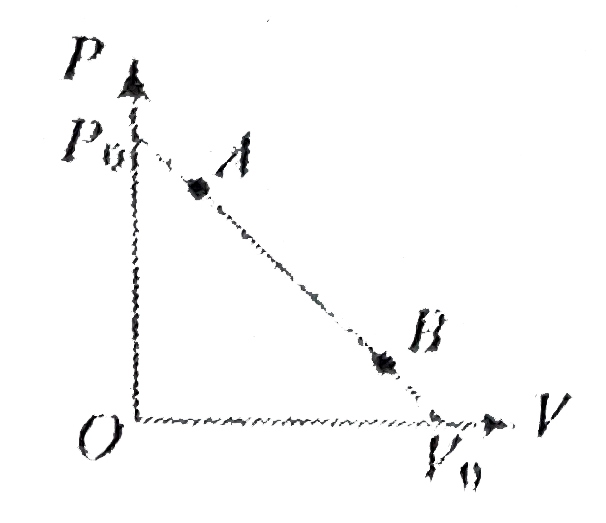Define Bulk modulus of elasticity and write an expression in terms of pressure .P., volume .V. and change in volume .ΔV..
Step-by-Step Solution
1. Definition of Bulk Modulus of Elasticity:
The bulk modulus of elasticity (B) is defined as the ratio of normal stress to the volume strain. It quantifies how incompressible a material is when subjected to uniform pressure.
2. Understanding Normal Stress:
Normal stress (σ) is defined as the force (F) applied per unit area (A). Mathematically, it can be expressed as:
σ=FA
In the context of bulk modulus, normal stress is often represented as pressure (P).
3. Understanding Volume Strain:
Volume strain (ΔV/V) is defined as the change in volume (ΔV) divided by the original volume (V). It can be expressed as:
Volume Strain=ΔVV
4. Expression for Bulk Modulus:
The bulk modulus (B) can be expressed in terms of pressure (P), original volume (V), and change in volume (ΔV) as:
B=−PΔVV
Here, the negative sign indicates that an increase in pressure results in a decrease in volume.
5. Final Expression:
Rearranging the above expression gives:
B=−P⋅VΔV
This shows the relationship between bulk modulus, pressure, original volume, and change in volume.
The bulk modulus of elasticity (B) is defined as the ratio of normal stress to the volume strain. It quantifies how incompressible a material is when subjected to uniform pressure.
Normal stress (σ) is defined as the force (F) applied per unit area (A). Mathematically, it can be expressed as:
σ=FA
In the context of bulk modulus, normal stress is often represented as pressure (P).
Volume strain (ΔV/V) is defined as the change in volume (ΔV) divided by the original volume (V). It can be expressed as:
Volume Strain=ΔVV
The bulk modulus (B) can be expressed in terms of pressure (P), original volume (V), and change in volume (ΔV) as:
B=−PΔVV
Here, the negative sign indicates that an increase in pressure results in a decrease in volume.
Rearranging the above expression gives:
B=−P⋅VΔV
This shows the relationship between bulk modulus, pressure, original volume, and change in volume.
Topper's Solved these Questions
- SAMPLE QUESTION PAPER - 01 BOOK - ICSECHAPTER - SAMPLE QUESTION PAPER - 01 EXERCISE - SECTION - C
14 Videos
- SAMPLE QUESTION PAPER - 01 BOOK - ICSECHAPTER - SAMPLE QUESTION PAPER - 01 EXERCISE - SECTION - D
12 Videos
- SAMPLE QUESTION PAPER - 01 BOOK - ICSECHAPTER - SAMPLE QUESTION PAPER - 01 EXERCISE - SECTION - D
12 Videos
- PROPERTIES OF MATTERBOOK - ICSECHAPTER - PROPERTIES OF MATTEREXERCISE - MODULE 4 ( TEMPERATURE ) UNSOLVED PROBLEMS
12 Videos
- SAMPLE QUESTION PAPER 4BOOK - ICSECHAPTER - SAMPLE QUESTION PAPER 4EXERCISE - SECTION - D (Answer all questions.)
7 Videos
Similar Questions
Write the relation between pressure and volume for an adiabatic change in an ideal gas.
View SolutionAssertion Bulk modulus of elasticity of gases is pressure dependent.
Reason More the pressure of gas, more is the Bulk modulus of elasticity of gas.
View SolutionAssertion : Bulk modulus of elasticity can be defined for all three states of matter, solid liquid and gas.
Reason: Young's modulus is not defined for liquids and gases.
View SolutionA metallic spherical shell has mas m, radius R and Bulk modulus of elasticity B. The change in radius of the shell due to gravitational pressure
View SolutionDefine the term volume of an object.
View SolutionThe pressure on an object of bulk modulus B undergoing hydraulic compression due to a stress exerted by surrounding fluid having volume strain (ΔVV)
View SolutionOne mole of an ideal monatomic gas undergoes a linear process from A to B , in which is pressure P and its volume V change as shown in figure .

The absolute temperature T versus volume V for the given process is
View SolutionOne mole of an ideal monatomic gas undergoes a linear process from A to B , in which is pressure P and its volume V change as shown in figure .

The absolute temperature T versus volume V for the given process is
View SolutionThe pressure P and volume V of an ideal gas both decreases in a process.
View SolutionDefine the explain bulk modulus of a material write its formula, explaining the significance of minus sign.
View Solution
